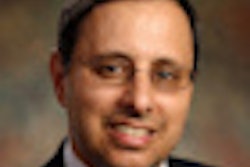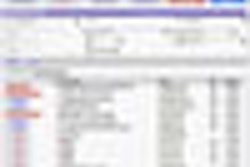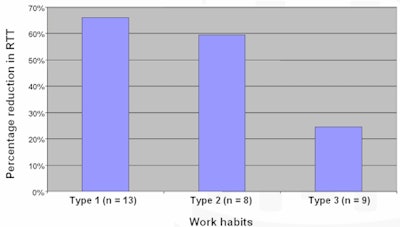
It's a well-known fact that implementing speech recognition (SR) technology can revolutionize report turnaround time and dramatically enhance the workflow efficiency of radiology departments. But can it improve the work habits of individual radiologists?
The answer: Yes, no, and maybe.
Presented at the 2008 RSNA annual meeting, a study that may be the first of its kind formally evaluated the effects of speech recognition technology on work habits by individual radiologist performance, by subspecialty section performance, and by the overall performance of a large department of an academic teaching hospital with respect to "before" and "after" report turnaround time.
Dr. Joseph T.K. Lee, chairman of the radiology department at the 700-bed University of North Carolina Hospitals in Chapel Hill, decided in 2005 that the purchase and implementation of a speech recognition system was necessary due to the potential for cost savings, according to poster session presenter Dr. Arun Krishnaraj, a radiology resident.
Data collection
During the nine-month period from January 2006 through September 2006, Krishnaraj and colleagues collected report turnaround time data on eight sections of the department (abdominal, breast imaging, cardiothoracic, musculoskeletal, neuroradiology, nuclear medicine, pediatrics, and vascular interventional radiology) and on the 30 full-time faculty members of the radiology department.
Report turnaround time was defined as the interval between the time the exam was available on PACS for interpretation to the time it was signed off by a radiologist.
The speech recognition system was installed in October 2006. "We waited six months to allow users to become adequately trained and comfortable with this new technology, and then we started to collect the same data for another nine months," Krishnaraj said. "Fortunately, our department is very stable and all 30 radiologists being evaluated were employees of the hospital for the entire data collection period, from January 2006 through December 2007."
The original workflow consisted of dictating a report for transcriptionists, reviewing the report on the radiology information system, making corrections, and electronically signing off. After sign-off, reports would be posted to the hospital's clinical information system. For reports dictated by residents, attending physicians would approve a report without corrections, correct the dictation themselves prior to finalizing reports, or return the reports for major corrections to residents.
After speech recognition was implemented (Talk Technology Version 3.0, Agfa HealthCare, Greenville, SC), radiologists were expected to self-edit and sign off on the reports they dictated at their diagnostic PACS workstations (Impax PACS, Agfa). After sign-off, the reports were added to the hospital's clinical information system.
The review of residents' dictated reports using a speech recognition system was more complex, so the researchers divided the faculty radiologists into three sections:
- Type 1: Radiologists who reviewed, revised, and finalized residents' reports at the time of image review
- Type 2: Radiologists who regularly verified and signed off on reports in several daily batches after residents made appropriate corrections
- Type 3: Radiologists who verified and signed off on reports once daily to biweekly
Results
"Our department improved its report turnaround time by more than 100%," Krishnaraj said. "With speech recognition, our entire department averaged 12.7 hours as compared to 28 hours before we implemented speech recognition. Performance by subspecialty section was even more dramatic overall, although individual section performance varied significantly."
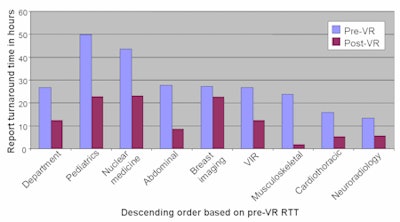 |
| Report turnaround times by subspecialty section of radiology department. Image courtesy of University of North Carolina Hospitals. |
Speech recognition technology also benefited individual radiologists with respect to reducing turnaround time, but the degree of improvement in performance correlated with the radiologists' professional work habits. Individuals who were more aware of their report turnaround times before speech recognition also sought to perform quickly after it was implemented. Six of the nine faculty members with the shortest turnaround times during the first data collection period also had the shortest times in the second. Three of the six slowest radiologists continued to lag behind the group after speech recognition was implemented.
|
"An individual's work habits impact the effectiveness of speech recognition technology," Krishnaraj commented. "Caseload doesn't significantly affect turnaround time. In a separate analysis that we conducted, we learned that the radiologist with the shortest report turnaround time following speech recognition implementation generated the most reports per month on average among all faculty members."
The rank order of radiologists' turnaround times in a department does not change with the implementation of a speech recognition system, according to Krishnaraj. This fact was further reinforced by the work habits of radiologists signing off on residents' reports.
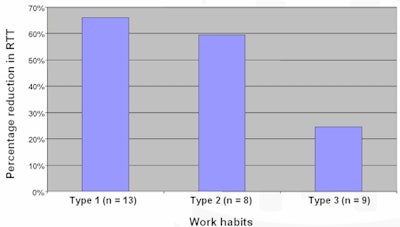 |
| Image courtesy of University of North Carolina Hospitals. |
Other findings included the following:
- Radiologists with the most rapid turnaround times learned to use the entire feature set and took advantage of it to improve their workflow.
- Radiologists who checked report queues frequently were faster.
- There was a performance correlation with the extent of training the radiologists gave the system to reduce errors in vocabulary recognition.
- Radiologists who requested IT support when encountering errors had faster turnaround times.
- Radiologists who reverted to the legacy dictation system had slower times on average.
"Understanding who needs to get involved and who can motivate others is the most important knowledge to possess to get universal adoption of a new technology and to benefit from its implementation," Krishnaraj concluded.
"Remember that there are radiologists who will not change poor work habits, and may not even respond to peer pressure," he said. "Recognizing the impact of individual work habits on the effect of productivity-enhancing technology may facilitate the design and implementation of similar technologies in the future and allow for more targeted solutions."
By Cynthia Keen
AuntMinnie.com staff writer
December 15, 2008
Related Reading
ED report turnaround times drop with speech recognition, November 19, 2008
Speech recognition shrinks report turnaround time, May 29, 2008
Voice recognition key to fast report turnaround, April 24, 2008
Keys to a successful voice recognition implementation, July 12, 2007
Patience pays off with voice recognition implementation, July 6, 2007
Copyright © 2008 AuntMinnie.com




